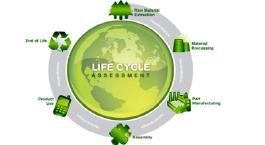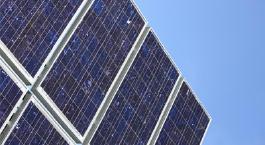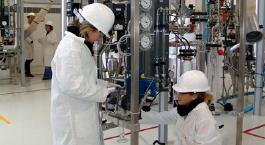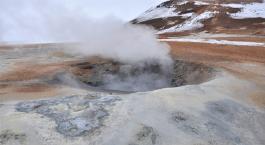The Sup'EnR engineering school is located at the heart of the renewable energies campus at Tecnosud, Perpignan, near the PROMES laboratory (CNRS), the 2PME "EnR et Greentech" business incubator and the DERBI competitiveness cluster dedicated to renewable energies.
Situated in the Pyrénées-Orientales region, Sup'EnR benefits from a unique location : all renewable energies are present in the department (solar, wind, geothermal, hydraulic, biomass). During technical visits and on-site teaching, students integrate technological and theoretical elements on a real-life scale.
Unique solar installations :
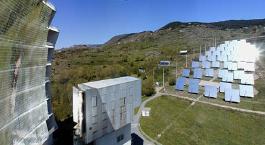
- Odeillo solar furnace (PROMES-CNRS): with the world's largest solar furnace (1 MW, 3300°C)
- 11 medium-power solar furnaces
- Thémis solar platform (CD66- PROMES-CNRS)
- e-LLO linear Fresnel solar power plant (9 MW)
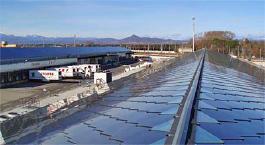
- Large-scale photovoltaic power plant integrated into the buildings of the Grand Saint Charles logistics center (9 MW, 68,000 m² of roof space)
- Parking decks, photovoltaic greenhouses...
- Agrivoltaic installations (Tressere, Llupia...)
Wind farms :
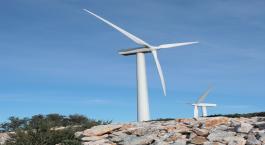
- Wind farm of Opoul-Périllos (10,5 MW)
- Wind farm of Rivesaltes (Repowered 11,2 MW), folding wind turbine
- Catalan wind eco-farm (96 MV)
- Offshore wind farm project
Hydraulic sites :
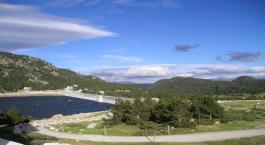
- Dams, penstocks and hydroelectric power plants in the Têt (50.9 MW) and Tech (20 MW) valleys
Geothermal sites :
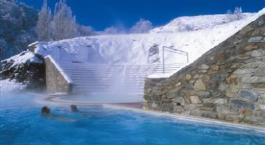
- Geothermal springs and hot-water baths (Saint-Thomas-les-Bains, Llo, Dorres, Thuès, Amélie-les-Bains, etc.)
- Solar thermal - geothermal hybrid systems ( Saint-Pierre-del-Forçats, etc...)
Biomass :

- Collective pellet or chip boilers
- Methanizers (biogas production)
- Renewable Energies
-
Cycle analysys
Life Cycle Assessment or LCA is an approach to estimating the environmental impact of a product or service throughout its life cycle. All stages in a product's life cycle must be taken into account: extraction of raw materials, manufacturing, distribution, use, end-of-life (recycling, incineration, landfill, etc.).Biomass
The sun's rays enable plants to grow through photosynthesis. This transformation of matter from light is the origin of all plants, and consequently of all biomass. Biomass therefore encompasses all organic matter produced by biological processes: terrestrial and aquatic plant species, agricultural residues, livestock waste, etc. Wood is the main constituent of solid biomass, as used in wood-fired boilers. Liquid biomass is based on vegetable oils (e.g. rapeseed) or alcohol (e.g. beet). Liquid biomass can be used as fuel in combustion engines. New generations of agrofuels are emerging: microalgae, plant parts unused by the food industry.Wind Power
Heat from the sun captured at ground or ocean surface level helps to raise the temperature of surrounding air masses and, consequently, their atmospheric pressure. The pressure difference between two air masses causes air to flow between them: this is wind, the source of wind energy. The aim of wind power is to harness the force exerted by the wind on moving surfaces to generate mechanical energy, which is then transformed into electricity. Blade design is based on the same technology used in aeronautics: the aim is to develop a geometry that enables the blade to efficiently convert the force of the wind, just as an aircraft wing exploits the force of lift. There are both horizontal-axis and vertical-axis wind turbines.Hydropower
Hydropower is energy generated by the movement of water. It can have various origins. Harnessing the flow of water in rivers is at the origin of hydroelectricity, the main form of renewable electricity generation today. In contrast, very little use is made of water in the sea, in the form of ocean currents. Wave energy is the energy generated by the action of the wind on the surface of the seas and oceans. To this rise in water level is added that caused by the gravitational attraction of earth-moon and earth-sun, which is none other than the tide.Solar power
Every second, the sun transforms millions of tons of matter into heat. As a result, the temperature at the Sun's center rises to tens of millions of degrees Celsius. This heat is radiated out into space, with only a tiny fraction being intercepted by the Earth. In one hour, the sun pours out the equivalent of the energy that humans consume in a year. The amount of energy received at ground level over the course of a year is constant, whatever the weather. This energy can be converted back into heat, mechanical energy or electricity. Examples of solar energy applications: solar water heaters, photovoltaic panels, tower power plants, Stirling parabolic troughs, parabolic trough power plants...Renewable energies
An energy source is considered renewable if it can be regenerated or renewed on a human scale. These include solar, wind, hydro, biomass and geothermal energy. All these forms of energy are generated by stars such as the sun, earth and moon. With the depletion of resources and climate disruption caused by greenhouse gases, the current energy system is difficult to maintain in its current state. Recourse to energy conservation, more efficient energy management and renewable energies is inevitable. But the random nature of weather patterns penalizes renewable energy systems (e.g. fluctuating sunshine or wind speed). So, in order to meet energy demands, it is necessary to implement energy storage systems.Process engineering
Process Engineering, a crossroads of disciplines, brings together the knowledge and know-how required for the industrial transformation of natural or synthetic raw materials into finished products through a succession of operations. Process engineering contributes to the major challenges of our century: controlling energy consumption, making optimum use of raw materials, and limiting environmental damage.Geothermal energy
The decay of radioactive elements in the earth's core releases such heat that it keeps the center at a temperature of over 7,000°C. Geothermal energy is the enormous amount of heat that flows through the earth's various layers. It is reflected in spectacular manifestations such as volcanoes and hydrothermal springs, but also in a thermal gradient. It is generally observed that temperatures vary by 1°C every 30 metres as you dig towards the center of the earth. By storing solar energy in the first few meters, the ground can release the heat needed to operate heat pumps at high efficiency. This is geosolar energy.
Updated : January 10, 2024


